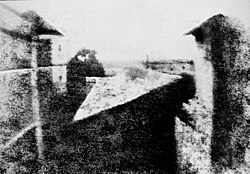The first permanent photograph was an image produced in 1826 by the French inventor Joseph Nicéphore Niépce. The word photography derives from the Greek words phōs (genitive: phōtós) light, and gráphein, to write. The word was coined by Sir John Frederick William Herschel in 1839.
On a summer day in 1827, Joseph Nicephore Niepce made the first photographic image with a camera obscura. Prior to Niepce people just used the camera obscura for viewing or drawing purposes not for making photographs. Joseph Nicephore Niepce'sheliographs or sun prints as they were called were the prototype for the modern photograph, by letting light draw the picture.
Niepce placed an engraving onto a metal plate coated in bitumen, and then exposed it to light. The shadowy areas of the engraving blocked light, but the whiter areas permitted light to react with the chemicals on the plate. When Niepce placed the metal plate in a solvent, gradually an image, until then invisible, appeared. However, Niepce's photograph required eight hours of light exposure to create and after appearing would soon fade away.
The Birth of Modern Photography
Louis Daguerre was the inventor of the first practical process of photography. In 1829, he formed a partnership with Joseph Nicephore Niepce to improve the process Niepce had developed.
In 1839 after several years of experimentation and Niepce's death, Daguerre developed a more convenient and effective method of photography, naming it after himself - the daguerreotype.
Daguerre's process 'fixed' the images onto a sheet of silver-plated copper. He polished the silver and coated it in iodine, creating a surface that was sensitive to light. Then, he put the plate in a camera and exposed it for a few minutes. After the image was painted by light, Daguerre bathed the plate in a solution of silver chloride. This process created a lasting image, one that would not change if exposed to light.
In 1839, Daguerre and Niepce's son sold the rights for the daguerreotype to the French government and published a booklet describing the process. The daguerreotype gained popularity quickly; by 1850, there were over seventy daguerreotype studios in New York City alone.

No comments:
Post a Comment